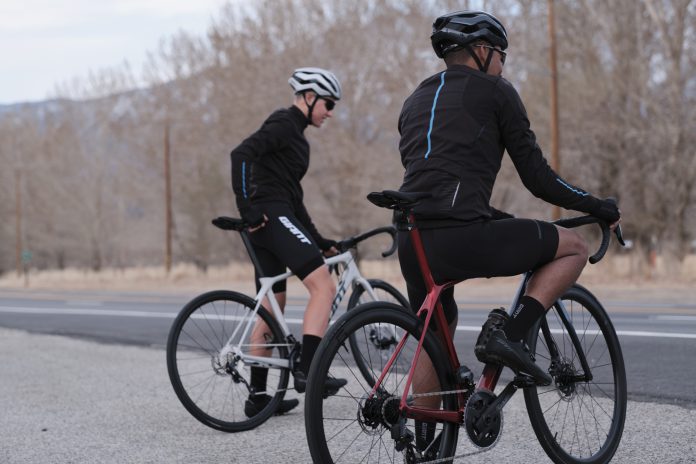If you’ve suddenly increased your miles on the bike, it might come with the uncomfortable side effect of saddle sores. Though they don’t necessarily have to ruin all your riding, we’ve put together some tips on how you can avoid getting saddle sores and how you can treat them if you’ve picked some up!

Most people will get a saddle sore at some point, no matter if you’re new to the sport or if you’ve been riding for years. Saddle sores range from a mild discomfort while you’re sat on the bike, to inflammation and antibiotics. There are a few steps you can do to make sure they don’t get too bad though.
What is a saddle sore?
Saddle sores are different in each case although the majority form as a raised, irritated area of skin in the area that makes the most contact with the saddle.
They can be caused by a number of things from friction and abrasion caused by chafing to infected hair follicles. In the case of the latter, they’ll take the form of something similar to a spot.
Best ways to avoid saddle sores:
Have a good bike fit.
The majority of saddle sores are caused in the same way chafing is. A good bike fit and saddle that correctly fits will mean you move around on the bike a lot less, so the contact area remains still. Getting comfortable is a huge component of a bike fit, to make sure you can sustain your position for a long period without having to move around.

Though the perfect saddle can be trial and error, a bike fit will be able to indicate which saddles would best suit you. As well as measuring exactly what width of saddle you need, these can be great tactics to keep the sores to a minimum. Your style of riding will greatly impact what sort of saddle is best to buy, and a good shop will be able to advise this.
If you often ride a TT bike or have an aggressive road style positioned on the front of the saddle, then a saddle to accommodate this will be important. If you ride with a more upright, endurance orientated position then your contact point may be further back on the saddle, which will need to be considered so your saddle will look very different. If you’re in neither bracket, don’t panic! There’s a whole range of saddles for different options, so you won’t be caught short. A bit of research and it’ll be easy to find a good solution
— WHY YOU NEED A NEW BIKE FIT —
Use chamois cream.
A lot of cyclists find that they can do incredible distances without ever using Chamois cream – it’s not a go to item for all cyclists. If you have a good pair of shorts and the right saddle, then there’s a chance you’ll be able to go without.

In a lot of cases, people wouldn’t even consider riding without Chamois cream – even with a great fitting bike and high quality kit. So don’t panic if it’s at the top of your list of things to grab before you go for a ride. If you’re prone to saddle sores then Chamois cream is a fantastic aid.
Chamois cream has a whole host of benefits that can help prevent saddle sores, from reducing chafing in the contact areas to providing anti-bacterial aids to limit infections in the area. Soothing ingredients like Shea Butter and Aloe Vera can help relax the area to avoid inflammation.
Buy high quality shorts.
All cycling shorts come with a small pad that sits between the body and the saddle, this is known as a chamois. You can buy a variety of pads from narrow to wide. The type of pad that will suit best varies from person to person and it’s entirely down to personal preference. Different brands have slightly different shaped pads which can also play a role.

If you’re getting a lot of chafing and it’s leading to saddle sores, then it could be worth trying another pair of shorts. Either a different shape or a different brand, both will offer you a new change with plenty of things to consider.
Making sure that you have the correct size when you’re picking shorts is important. If you pick a size that’s too small they can dig in and cause rubbing in uncomfortable places, whereas shorts that are too large will be slightly baggy and move around. Both scenarios are more likely to leave you with saddle sores.
Wash your kit.
If you’re doing a multi-day adventure, then it can be quite hard to wash your shorts every day. Though outside of that scenario, there’s no excuses not to wash your kit as frequently as possible. Cycling shorts and tights are designed to be made without any layers underneath them, so make sure you don’t ride with underwear or base layers.

If you ride with layers underneath then it can make the chaffing a lot worse. And like underwear, cycling kit should be washed after every outing to avoid any bacteria growing and causing infections.
It’s also important to change and shower out of cycling kit as soon as possible after a ride. This will stop any bacteria growing while you’re still in the shorts and allow your delicate areas to begin to recover.
Avoid hair removal.
Road cyclists are renowned for shaving their legs, though we’re still unsure why! If you need a good excuse to convince your partner to stop, then maybe saddle sores could come as the perfect one!
Shaving hair too high up the leg can leave the risk of ingrown hairs and therefore infections. Hair can also help prevent friction in certain areas, so being careful around the areas you shave can help reduce the risk of saddle sores.
— WHY DO ROAD CYCLISTS SHAVE THEIR LEGS —
How to treat saddle sores.
Rest.
A few days off the bike can give your body enough time to tend to the affected area. As well as this you can wear clothes that aren’t too tight to give the area a chance to breathe and recover. If you’re desperate to train then alternatives like cross training or running could be a good short term alternative, but you won’t get any slower with a few days off, promise!

Keep clean & fresh.
Washing the area regularly with a soap that isn’t too intrusive. Using products that are good for sensitive skin for a short period of time can also let the sores recover. If you do the best to keep the area clean & dry, your body will take care of the rest.
— THE ROAD CYCLING DICTIONARY – HOW TO TALK CYCLIST —
Know when to see a GP.
The majority of saddle sores are minor and issues will clear up in a few days, so if you have any lingering issues it’s best to get hold of the GP. Alternatively if your saddle sores are so bad they’re causing issues with sitting, walking or otherwise, it might be best to get some antibiotics!
If you’re having issues with saddle sores we hope these tips can help you get sorted, and get back out on the bike soon!








